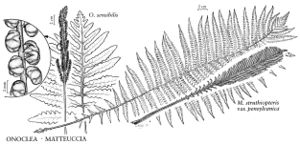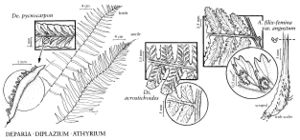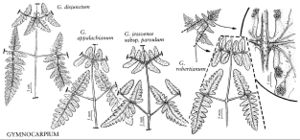Difference between revisions of "Dryopteridaceae"
FNA>Volume Importer |
imported>Volume Importer |
||
| (7 intermediate revisions by 2 users not shown) | |||
| Line 13: | Line 13: | ||
}}<!-- | }}<!-- | ||
| − | --><span class="statement" id="st- | + | --><span class="statement" id="st-undefined" data-properties=""><b>Plants </b>perennial, terrestrial or on rock, occasionally hemiepiphytic or epiphytic. <b>Stems</b> creeping to erect, rarely arborescent, sometimes climbing, branched or unbranched, dictyostelic, bearing scales. <b>Leaves</b> circinate in bud, monomorphic or dimorphic. <b>Petiole</b> usually not articulate to stem, scales usually persistent at base, in cross section with 2–many roundish bundles, or bundles 2 and lunate. <b>Blade</b> simple to commonly 1–5-pinnate or more divided, leaf buds absent or present. <b>Veins</b> pinnate or parallel in ultimate segments, simple or forked, free or anastomosing, areoles sometimes with included free veinlets. <b>Indument</b> on blade commonly of glands, hairs, and/or scales, especially on rachis and costae abaxially. <b>Sori</b> borne abaxially on veins or at vein tips (but usually not marginal), or sporangia acrostichoid and covering abaxial surface, if in discrete sori then variously shaped (round, oblong, or elongate); receptacle not or only slightly elevated, with or without indusium, indusium variously linear, falcate, or reniform, sometimes hoodlike, cuplike, or round. <b>Sporangia</b> with stalk of 2–3 rows of cells; annulus vertical, interrupted by stalk. <b>Spores</b> all of 1 kind, usually not green (except <i>Matteuccia</i>, <i>Onoclea</i>), oblong or reniform in outline, monolete, variously ornamented (often broadly winged), 64 per sporangium (32 in apogamous spp.). <b>Gametophytes</b> green, aboveground, cordate, glabrous or often bearing glands or hairs; archegonia and antheridia borne on lower surface, antheridia 3-celled.</span><!-- |
-->{{Treatment/Body | -->{{Treatment/Body | ||
|distribution=Worldwide. | |distribution=Worldwide. | ||
| − | |discussion=<p>The family Dryopteridaceae has been variously circumscribed; it is here delimited in a manner similar to that of R. M. Tryon and A. F. Tryon (1982) but with the inclusion of Nephrolepis. In many works, the family has gone under the illegitimate name Aspidiaceae. Some authorities define Dryopteridaceae more narrowly, to exclude Athyrium, Deparia, Diplazium, Cystopteris, and Gymnocarpium (Athyriaceae or Woodsiaceae), Woodsia (Woodsiaceae), Lomariopsis (Lomariopsidaceae), Nephrolepis (Nephrolepidaceae or Davalliaceae), Onoclea and Matteuccia (Onocleaceae), and Ctenitis and Tectaria (Tectariaceae). Characteristics holding Dryopteridaceae (as circumscribed here) together include the bilateral, monolete spores, often broadly winged perispore, absence of needlelike hairs, scaly stem and petiole bases, abaxial (nonmarginal) sori, base chromosome number of 40 or 41 (also 38 and 39 in Woodsia, 37 in Onoclea, 42 in Cystopteris), and usually indusiate sori. Loss of indusium, dimorphism, areolate venation, and reduced blade dissection have occurred repeatedly along many evolutionary lines in Dryopteridaceae, and in general these characteristics are often not very useful in delimiting genera or assessing intergeneric relationships.</p><!-- | + | |discussion=<p>The family Dryopteridaceae has been variously circumscribed; it is here delimited in a manner similar to that of R. M. Tryon and A. F. Tryon (1982) but with the inclusion of <i>Nephrolepis</i>. In many works, the family has gone under the illegitimate name Aspidiaceae. Some authorities define Dryopteridaceae more narrowly, to exclude <i>Athyrium</i>, <i>Deparia</i>, <i>Diplazium</i>, <i>Cystopteris</i>, and <i>Gymnocarpium</i> (Athyriaceae or Woodsiaceae), <i>Woodsia</i> (Woodsiaceae), <i>Lomariopsis</i> (Lomariopsidaceae), <i>Nephrolepis</i> (Nephrolepidaceae or Davalliaceae), <i>Onoclea</i> and <i>Matteuccia</i> (Onocleaceae), and <i>Ctenitis</i> and <i>Tectaria</i> (Tectariaceae). Characteristics holding Dryopteridaceae (as circumscribed here) together include the bilateral, monolete spores, often broadly winged perispore, absence of needlelike hairs, scaly stem and petiole bases, abaxial (nonmarginal) sori, base chromosome number of 40 or 41 (also 38 and 39 in <i>Woodsia</i>, 37 in <i>Onoclea</i>, 42 in <i>Cystopteris</i>), and usually indusiate sori. Loss of indusium, dimorphism, areolate venation, and reduced blade dissection have occurred repeatedly along many evolutionary lines in Dryopteridaceae, and in general these characteristics are often not very useful in delimiting genera or assessing intergeneric relationships.</p><!-- |
| − | --><p>In some genera, especially Phanerophlebia and Polystichum, the blade bears very narrow scales (sometimes called microscales) that resemble uniseriate hairs. These scales may be only one or two cells wide. Every intergradation exists between these filiform microscales and more typical, wider scales, and the two types are the same color, generally tan to brownish. Microscales are probably not homologous with true hairs, which may be either unicellular or multicellular, uncolored or sometimes reddish (as in Tectaria and Ctenitis), glandular (as in Woodsia) or not. Hairs in Dryopteridaceae, if present at all, are generally readily distinguishable from the needlelike, transparent ones found in Thelypteridaceae.</p><!-- | + | --><p>In some genera, especially <i>Phanerophlebia</i> and <i>Polystichum</i>, the blade bears very narrow scales (sometimes called microscales) that resemble uniseriate hairs. These scales may be only one or two cells wide. Every intergradation exists between these filiform microscales and more typical, wider scales, and the two types are the same color, generally tan to brownish. Microscales are probably not homologous with true hairs, which may be either unicellular or multicellular, uncolored or sometimes reddish (as in <i>Tectaria</i> and <i>Ctenitis</i>), glandular (as in <i>Woodsia</i>) or not. Hairs in Dryopteridaceae, if present at all, are generally readily distinguishable from the needlelike, transparent ones found in Thelypteridaceae.</p><!-- |
--><p>Genera ca. 60, species perhaps exceeding 3000 (18 genera, 79 species in the flora).</p> | --><p>Genera ca. 60, species perhaps exceeding 3000 (18 genera, 79 species in the flora).</p> | ||
|tables= | |tables= | ||
| Line 202: | Line 202: | ||
|family=Dryopteridaceae | |family=Dryopteridaceae | ||
|illustrator=John Myers | |illustrator=John Myers | ||
| + | |illustration copyright=Flora of North America Association | ||
|distribution=Worldwide. | |distribution=Worldwide. | ||
|reference=None | |reference=None | ||
| Line 207: | Line 208: | ||
|publication year= | |publication year= | ||
|special status= | |special status= | ||
| − | |source xml=https:// | + | |source xml=https://bitbucket.org/aafc-mbb/fna-data-curation/src/2e0870ddd59836b60bcf96646a41e87ea5a5943a/coarse_grained_fna_xml/V2/V2_70.xml |
| − | |||
| − | |||
| − | |||
| − | |||
| − | |||
| − | |||
| − | |||
| − | |||
| − | |||
| − | |||
| − | |||
| − | |||
| − | |||
| − | |||
| − | |||
| − | |||
| − | |||
| − | |||
| − | |||
| − | |||
| − | |||
| − | |||
| − | |||
| − | |||
| − | |||
| − | |||
| − | |||
| − | |||
| − | |||
| − | |||
| − | |||
| − | |||
| − | |||
| − | |||
| − | |||
| − | |||
| − | |||
| − | |||
| − | |||
| − | |||
| − | |||
| − | |||
| − | |||
| − | |||
}}<!-- | }}<!-- | ||
-->[[Category:Treatment]] | -->[[Category:Treatment]] | ||
Latest revision as of 20:24, 5 November 2020
Plants perennial, terrestrial or on rock, occasionally hemiepiphytic or epiphytic. Stems creeping to erect, rarely arborescent, sometimes climbing, branched or unbranched, dictyostelic, bearing scales. Leaves circinate in bud, monomorphic or dimorphic. Petiole usually not articulate to stem, scales usually persistent at base, in cross section with 2–many roundish bundles, or bundles 2 and lunate. Blade simple to commonly 1–5-pinnate or more divided, leaf buds absent or present. Veins pinnate or parallel in ultimate segments, simple or forked, free or anastomosing, areoles sometimes with included free veinlets. Indument on blade commonly of glands, hairs, and/or scales, especially on rachis and costae abaxially. Sori borne abaxially on veins or at vein tips (but usually not marginal), or sporangia acrostichoid and covering abaxial surface, if in discrete sori then variously shaped (round, oblong, or elongate); receptacle not or only slightly elevated, with or without indusium, indusium variously linear, falcate, or reniform, sometimes hoodlike, cuplike, or round. Sporangia with stalk of 2–3 rows of cells; annulus vertical, interrupted by stalk. Spores all of 1 kind, usually not green (except Matteuccia, Onoclea), oblong or reniform in outline, monolete, variously ornamented (often broadly winged), 64 per sporangium (32 in apogamous spp.). Gametophytes green, aboveground, cordate, glabrous or often bearing glands or hairs; archegonia and antheridia borne on lower surface, antheridia 3-celled.
Distribution
Worldwide.
Discussion
The family Dryopteridaceae has been variously circumscribed; it is here delimited in a manner similar to that of R. M. Tryon and A. F. Tryon (1982) but with the inclusion of Nephrolepis. In many works, the family has gone under the illegitimate name Aspidiaceae. Some authorities define Dryopteridaceae more narrowly, to exclude Athyrium, Deparia, Diplazium, Cystopteris, and Gymnocarpium (Athyriaceae or Woodsiaceae), Woodsia (Woodsiaceae), Lomariopsis (Lomariopsidaceae), Nephrolepis (Nephrolepidaceae or Davalliaceae), Onoclea and Matteuccia (Onocleaceae), and Ctenitis and Tectaria (Tectariaceae). Characteristics holding Dryopteridaceae (as circumscribed here) together include the bilateral, monolete spores, often broadly winged perispore, absence of needlelike hairs, scaly stem and petiole bases, abaxial (nonmarginal) sori, base chromosome number of 40 or 41 (also 38 and 39 in Woodsia, 37 in Onoclea, 42 in Cystopteris), and usually indusiate sori. Loss of indusium, dimorphism, areolate venation, and reduced blade dissection have occurred repeatedly along many evolutionary lines in Dryopteridaceae, and in general these characteristics are often not very useful in delimiting genera or assessing intergeneric relationships.
In some genera, especially Phanerophlebia and Polystichum, the blade bears very narrow scales (sometimes called microscales) that resemble uniseriate hairs. These scales may be only one or two cells wide. Every intergradation exists between these filiform microscales and more typical, wider scales, and the two types are the same color, generally tan to brownish. Microscales are probably not homologous with true hairs, which may be either unicellular or multicellular, uncolored or sometimes reddish (as in Tectaria and Ctenitis), glandular (as in Woodsia) or not. Hairs in Dryopteridaceae, if present at all, are generally readily distinguishable from the needlelike, transparent ones found in Thelypteridaceae.
Genera ca. 60, species perhaps exceeding 3000 (18 genera, 79 species in the flora).
Selected References
None.
Lower Taxa
Illustrations
Key
| 1 | Leaves strongly dimorphic, either fertile or sterile, the 2 types very dissimilar. | > 2 |
| 1 | Leaves monomorphic, fertile and sterile similar in size and dissection, occasionally with somewhat contracted fertile pinnae on same leaf as sterile pinnae (as in Polystichum acrostichoides). | > 5 |
| 2 | Sporangia completely covering abaxial surface of blade, not in discrete sori or hidden by revolute segment margins; sterile blades 1-pinnate, pinnae serrate. | Lomariopsis |
| 2 | Sporangia not covering abaxial surface of blade, in discrete sori or hidden by revolute segment margins; sterile blades variously divided, not 1-pinnate with pinnae serrate. | > 3 |
| 3 | Plants hemiepiphytic, rooted in ground and with stems climbing trees; sterile blades 3-4-pinnate; indusia thick, conspicuous. | Maxonia |
| 3 | Plants terrestrial, not climbing; sterile blades deeply pinnatifid to 1-pinnate-pinnatifid; indusia thin, fragile, hidden by revolute segment margins. | > 4 |
| 4 | Sterile blades pinnatifid to 1-pinnate at base; venation areolate; fertile blades 2-pinnate, sori enclosed in small, globose, hardened pinnules. | Onoclea |
| 4 | Sterile blades 1-pinnate-pinnatifid; veins free; fertile blades 1-pinnate, sori on linear pinnae and enclosed by hardened pinna margin. | Matteuccia |
| 5 | Stolons present, wiry, arising from stem; blades 1-pinnate; pinnae articulate to rachis, sometimes deciduous with age; indusia lunate to reniform or circular with narrow sinus. | Nephrolepis |
| 5 | Stolons absent; blades variously divided; pinnae not articulate to rachis, or rarely proximal pinnae weakly articulate but not deciduous; indusia various or absent. | > 6 |
| 6 | Indusia completely surrounding receptacle and composed of filaments or scalelike segments arranged in cuplike fashion around sorus; petiole base with 2 vascular bundles; scales absent on costae abaxially. | Woodsia |
| 6 | Indusia attached centrally or laterally, not completely surrounding receptacle, or indusia absent; petiole base with 2 or more vascular bundles; scales absent or present on costae abaxially. | > 7 |
| 7 | Veins areolate or copiously anastomosing. | > 8 |
| 7 | Veins free or only casually and sparingly anastomosing. | > 10 |
| 8 | Sori and indusia linear; petiole base with 2 vascular bundles. | Diplazium |
| 8 | Sori round, with indusia round or round-reniform; petiole base with many vascular bundles. | > 9 |
| 9 | Costae adaxially rounded or flattened, bearing multicellular reddish hairs; margins of pinnae lacking spinules or teeth. | Tectaria |
| 9 | Costae adaxially grooved, lacking reddish multicellular hairs but sometimes with tan, very reduced, filiform scales; margins of pinnae spinulose to denticulate or crenate. | Cyrtomium |
| 10 | Indusia round, attached at center (peltate); sori round; petiole base with 3 or more vascular bundles. | > 11 |
| 10 | Indusia round-reniform, reniform, linear, or absent, attached laterally at sinus; sori round or elongate; petiole base with 2 or more vascular bundles. | > 12 |
| 11 | Blades 1-pinnate with terminal pinna similar to lateral pinnae; sori in 2-4 rows between costa and margin; s Arizona to w Texas. | Phanerophlebia |
| 11 | Blades 1-3-pinnate with gradually reduced and pinnatifid apex; sori in 1(-2) rows between costa and margin or between costule and margin; widespread. | Polystichum |
| 12 | Sori elongate, straight or hooked at one end, indusiate; petiole base with 2 vascular bundles. | > 13 |
| 12 | Sori round or nearly so, indusia present or absent; petiole with 2 or more vascular bundles. | > 15 |
| 13 | Adaxial grooves of costae shallow, not decurrent into rachis groove; multicellular hairs borne along costae, especially adaxially; stems moderately long-creeping; blades 1-pinnate-pinnatifid. | Deparia |
| 13 | Adaxial grooves of costae deep, decurrent into rachis groove; multicellular hairs absent on costae; stems short-creeping to erect; blades 1-pinnate to 2-pinnate-pinnatifid. | > 14 |
| 14 | Blades commonly 2-pinnate or more divided; proximal pinnae often slightly to greatly reduced; sori usually hooked at distal end. | Athyrium |
| 14 | Blades 1-pinnate, 1-pinnate-pinnatifid, or 2-pinnate (if 2-pinnate then veins anastomosing); proximal pinnae not or slightly reduced; sori ± straight, not hooked at distal end. | Diplazium |
| 15 | Costae rounded or flat adaxially, bearing dense, obviously multicellular hairs with reddish crosswalls. | Ctenitis |
| 15 | Costae grooved adaxially, lacking hairs. | > 16 |
| 16 | Indusia attached at distinct sinus, round-reniform; petiole base with 3 or more vascular bundles. | > 17 |
| 16 | Indusia absent or laterally attached and hoodlike, arching over sori; petiole base with 2 vascular bundles. | > 18 |
| 17 | Stems short-creeping, nearly erect or erect; blades lanceolate to ovate, not pentagonal; widespread. | Dryopteris |
| 17 | Stems moderately long-creeping; blades pentagonal, with basal basiscopic pinnules decidedly longer than next pair; South Carolina. | Arachniodes |
| 18 | Stems long-creeping; blades deltate to pentagonal, proximal pinnae by far the largest; petioles mostly 1/3-3 times length of blades. | > 19 |
| 18 | Stems short-creeping to ascending; blades ovate to lanceolate, proximal pinnae occasionally slightly longer than adjacent pair; petioles mostly shorter than blades. | > 20 |
| 19 | Indusia present but often inconspicuous in mature leaves, laterally attached and arching over sori; segment margins serrate-dentate (Cystopteris montana). | Cystopteris |
| 19 | Indusia always absent; segment margins entire or crenate but never serrate-dentate. | Gymnocarpium |
| 20 | Indusia absent from all sori; stems erect to ascending, surface obscured by petiole bases and scales, scales more than 5 mm. | Athyrium |
| 20 | Indusia present but often inconspicuous in mature leaves, laterally attached and arching over sori; stems decumbent, usually creeping, surface often visible through petiole bases and scales, scales less than 5 mm. | Cystopteris |


